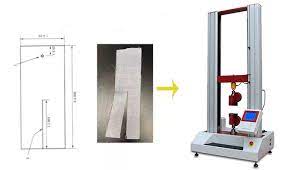- Qinsun Instruments Co., Ltd.
- Tell:+86-21-6780 0179
- Phone:+86-17740808215
- Address:No. 2578 Minhang District Gu Dai Road, Shanghai
- Contact:Mr. Li
- QQ:846490659
What is the standard of the fabric tear strength test?

The fabric tear strength test is conducted to determine the force required to tear a fabric specimen. The tear strength of a fabric is an important parameter that helps evaluate its durability and resistance to tearing or ripping during use. Several international organizations and standards bodies have developed standards and test methods to ensure consistent and reliable measurement of fabric tear strength. Some of the key standards and test methods include:
1. ASTM D1424 - Standard Test Method for Tearing Strength of Fabrics by Falling-Pendulum (Elmendorf-Type) Apparatus:
This test method is commonly used to determine the tearing strength of both woven and nonwoven fabrics. It involves using a pendulum-type apparatus that consists of a pendulum arm fitted with a cutting blade. The fabric sample is clamped onto a base, and the pendulum blade is released to tear through the fabric. The energy required for tearing is measured and used to calculate the tear strength.
2. ASTM D5733 - Standard Test Method for Tearing Strength of Nonwoven Fabrics by the Trapezoid Procedure:
This ASTM standard is specifically designed for testing the tearing strength of nonwoven fabrics. The test specimen is cut in a specified trapezoidal shape, and it is clamped in the grips of the testing machine. The machine applies a force until the fabric specimen tears. The maximum force applied is recorded and used to calculate the tear strength.
3. ISO 13937-2 - Textiles - Tear Properties of Fabrics - Part 2: Determination of Tear Force of Elongation at 90°:
ISO 13937-2 is an international standard that establishes the procedures for determining the tear force and elongation of fabrics when subjected to a standardized trapezoidal tearing force. This standard specifies the testing equipment, sample preparation, and testing procedure for conducting the tear test.
4. ISO 13937-3 - Textiles - Tear Properties of Fabrics - Part 3: Determination of Tear Force of a Circular Specimen:
ISO 13937-3 is another part of the international standard that focuses on the determination of tear force using a circular specimen instead of a trapezoidal one. The testing apparatus, sample preparation, and procedure are defined in this standard.
5. SATRA TM 24 - Tear Strength (Single Rip) Test:
SATRA, a leading research and testing organization, has developed its test method for determining the tear strength of fabrics using the single rip procedure. This test uses a tongue-shaped specimen, and the force required to tear the fabric is measured. SATRA TM 24 is widely used in the footwear and leather goods industries for evaluating material strength.

6. AATCC 16 - Tear Strength of Fabrics by the Trapezoid Procedure:
AATCC 16 is a test method developed by the American Association of Textile Chemists and Colorists (AATCC) to measure the tear strength of fabrics using the trapezoid procedure. This standard includes the requirements for the testing equipment, sample preparation, and testing procedure.
7. GB/T 16578 - Textiles - Determination of Tear Resistance - Part 1: Constant-Rate-of-Extension Procedure:
GB/T 16578 is a Chinese national standard that defines the constant-rate-of-extension (CRE) tear test method for determining the tear resistance of textiles. It provides guidelines for sample preparation, testing equipment, and testing procedure.
These are just a few examples of the numerous standards and test methods available for fabric tear strength testing. The choice of standard depends on factors such as the type of fabric being tested, the industry requirements, and regional regulations. It is crucial to refer to the specific standard applicable to your industry or region for accurate and consistent testing procedures.
It's worth noting that standards can be updated or revised over time. Therefore, it is important to stay up to date and ensure compliance with the latest versions of the standards relevant to your industry.





